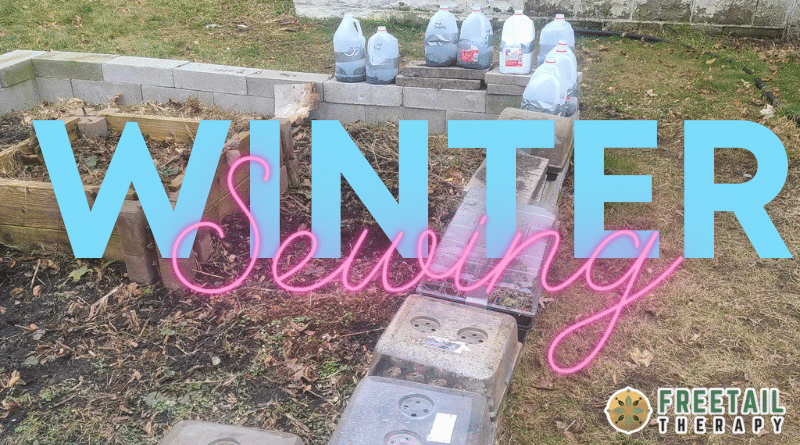Winter Sowing: The Trudi Davidoff Method
Gardening enthusiasts and friends, today I’m thrilled to share with you the transformative technique of winter sowing, a term coined and popularized by Trudi Greissle Davidoff in collaboration with the USDA. This isn’t just about growing things in winter; it’s a specific method that harnesses the conditions of nature to cultivate robust, hardy seedlings with high germination rates. Let’s unravel the genius behind this method and how you can apply it to get the sturdiest plants in your own garden!
Understanding Winter Sowing
Winter sowing aligns with the natural cycle that begins on the winter solstice, the time when seeds are traditionally sown into containers and exposed to the winter elements. This method emulates nature’s own stratification process, where seeds lay dormant through winter’s freeze and thaw cycles, breaking down their hard coatings and preparing them for germination. By placing seeds into makeshift greenhouses—recycled containers filled with soil—we create a micro-environment that mimics these natural conditions. The seeds experience all the cues of winter, ensuring they sprout as robust, weather-hardened seedlings ready to thrive when spring unfurls. It’s a hands-off, patient approach that trusts in the wisdom of the earth, readying for the burst of life that comes with the longer days ahead.
The Container Setup
Any container that can hold a good amount of potting soil and provide headroom for the seedlings’ growth will do. The container should be translucent to let in light but not so transparent that it fails to offer some protection from the full intensity of the sun.
Here’s How You Can Start:
- Choose Your Container: A milk jug, a water bottle, or any other container, as long as it’s at least 3-4″ deep for potting mix and has 2″ or more headroom for seedlings. Remember, the container should be translucent, not transparent.
- Drainage Is Key: Make plenty of drainage holes in the bottom. If you’re doubting your container’s ability to drain, you likely need more holes.
- Prepare the Soil: Fill your container with a potting mix and moisten it well. If it feels too wet, again, consider your drainage holes.
- Sow Your Seeds: Start with perennials that require cold stratification, and then move to hardy annuals, and later to tender annuals.
- Labeling: Use a permanent marker to label your containers. It’s wise to mark in a way that the sun won’t fade the writing. Place an additional plant marker inside as a backup.
- Secure and Ventilate: Close your container securely with tape or any other method that keeps the lid on. Make sure there are ventilation holes at the top.
- Light and Exposure: Place your containers outside where they can get light and be exposed to rain and snow.
Maintenance and Monitoring
- Moisture: Check your containers for moisture, especially if there’s been a lack of rain or snow or if windy conditions prevail. The soil should stay moist.
- Germination Conditions: Your seeds will germinate when the conditions are right for each particular type of seed.
- Spring Adjustments: As temperatures rise in spring and germination occurs, provide more ventilation or move containers to a shadier location if necessary.
Transplanting Seedlings
When your seedlings have two sets of true leaves and are about 2″ tall, they are ready to be transplanted to your garden. Don’t leave seedlings in their containers too long; they need fresh soil and room to grow. If you can’t transplant them immediately, pot them up to give them more nutrients.
Embracing the Natural Process
Winter sowing is a testament to the resilience and intelligence of nature’s own processes. This technique bypasses the traditional indoor seed starting, instead placing trust in the elements to prepare seedlings for the world outside the greenhouse. By sowing seeds into containers during the cold months, we’re not simply biding our time until the last frost has passed; we are actively conditioning our young plants to endure and even thrive amidst the fluctuations of early spring weather. These seedlings, having germinated and grown in the very conditions they will face in the garden, are inherently robust and ready for early transplanting. They’ve been hardened by the very breezes and chills that might wither less prepared plants, making winter sowing a strategic move for the gardener looking to work with, rather than against, the rhythms of nature.
Trudi’s Words of Wisdom
Trudi Davidoff is a pioneering figure in the gardening world, best known for popularizing the winter sowing method, a simple and eco-friendly approach to seed germination that leverages the natural winter conditions to simulate the stratification process. Her philosophy emphasizes ease and minimal intervention, advocating for using recycled translucent containers to create mini greenhouses that are left outdoors through winter. This hands-off method allows seeds to naturally freeze and thaw, preparing them for robust growth in spring. Davidoff’s approach has resonated with gardeners globally, advocating that if gardening feels overly complicated, it might not be in true alignment with the simplicity and wisdom of nature. Through her advocacy and educational efforts, Trudi has built a community around winter sowing, encouraging sustainable gardening practices and a deeper connection with the earth’s natural rhythms. Remember, as Trudi says, if it’s not easy, you’re probably not doing it right. Winter sowing should be a straightforward, hands-off approach that yields impressive results with minimal intervention.
Final Thoughts
Winter sowing is about trust — trust in the natural process and in the resilience of the seedlings. It’s a journey of patience and discovery. So, as you embark on this method, take the time to learn from your garden, and let your winter sowing adventure begin!



